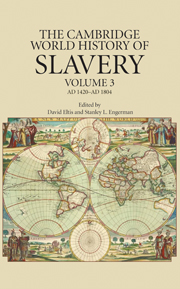Book contents
- Frontmatter
- Contents
- List of Maps, Figures, and Tables
- Contributors
- Series Editors' Introduction
- 1 Dependence, Servility, and Coerced Labor in Time and Space
- PART I SLAVERY IN AFRICA AND ASIA MINOR
- PART II SLAVERY IN ASIA
- PART III SLAVERY AMONG THE INDIGENOUS AMERICANS
- PART IV SLAVERY AND SERFDOM IN EASTERN EUROPE
- 11 Russian Slavery and Serfdom, 1450–1804
- 12 Manorialism and Rural Subjection in East Central Europe, 1500–1800
- PART V SLAVERY IN THE AMERICAS
- PART VI CULTURAL AND DEMOGRAPHIC PATTERNS IN THE AMERICAS
- PART VII LEGAL STRUCTURES, ECONOMICS, AND THE MOVEMENT OF COERCED PEOPLES IN THE ATLANTIC WORLD
- PART VIII SLAVERY AND RESISTANCE
- Index
11 - Russian Slavery and Serfdom, 1450–1804
from PART IV - SLAVERY AND SERFDOM IN EASTERN EUROPE
Published online by Cambridge University Press: 28 September 2011
- Frontmatter
- Contents
- List of Maps, Figures, and Tables
- Contributors
- Series Editors' Introduction
- 1 Dependence, Servility, and Coerced Labor in Time and Space
- PART I SLAVERY IN AFRICA AND ASIA MINOR
- PART II SLAVERY IN ASIA
- PART III SLAVERY AMONG THE INDIGENOUS AMERICANS
- PART IV SLAVERY AND SERFDOM IN EASTERN EUROPE
- 11 Russian Slavery and Serfdom, 1450–1804
- 12 Manorialism and Rural Subjection in East Central Europe, 1500–1800
- PART V SLAVERY IN THE AMERICAS
- PART VI CULTURAL AND DEMOGRAPHIC PATTERNS IN THE AMERICAS
- PART VII LEGAL STRUCTURES, ECONOMICS, AND THE MOVEMENT OF COERCED PEOPLES IN THE ATLANTIC WORLD
- PART VIII SLAVERY AND RESISTANCE
- Index
Summary
Medieval Russia (Ukraine, Belorussia, Great Russia) did not know serfdom. There was free land everywhere, and no elite social group that depended on agriculture for its livelihood. Population was very sparse, but perceived labor shortages could not be made up by attempts to enserf the peasants en masse. As the number of political jurisdictions multiplied, they had disputes over labor, but there were no political or judicial institutions that could enforce serfdom by binding peasants to the land. Those who indirectly depended on peasant agricultural output had to go to find the peasants to tax them. Agriculture, moreover, was of the slash-and-burn type, with the result that peasants farmed a different site roughly every three years. Landlords were few in the pre-1350 era, and any landlord who tried to control peasant labor had to contend with a peasantry used to moving, and who would pick up and move away from any landlord desirous of collecting rent. Slavery, by contrast, was an ancient institution in Russia and effectively was abolished in the 1720s. Serfdom, which began in 1450, evolved into near-slavery in the eighteenth century and was finally abolished in 1906. Serfdom in its Russian variant could not have existed without the precedent and presence of slavery.
- Type
- Chapter
- Information
- The Cambridge World History of Slavery , pp. 275 - 296Publisher: Cambridge University PressPrint publication year: 2011
- 2
- Cited by

